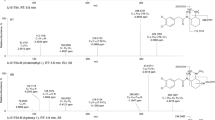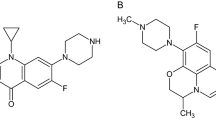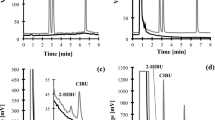Abstract
SEVERAL workers have found a spot isographic with 3,4-dimethoxyphenethylamine (DMPEA) in urine chromatograms of some schizophrenic patients but never or rarely in those of non-schizophrenic persons1–3. A metabolite of chlorpromazine (CPZ), however, noted4 to have been identified as nor2chlorpromazine Sulphoxide (N2CPSO)5, causes a spot close to or isographic with DMPEA in the chromatographic system originally used to detect the spots apparently diagnostic of schizophrenia4,5 (referred to below as system 1). If a phenothiazine metabolite caused the apparently diagnostic spots (the pink spots) the following conditions must be fulfilled. (1) The RF for the metabolite in system 1 should be almost identical to that of DMPEA because fifteen pink spots were originally studied and even a small consistent difference in RF between these spots and authentic DMPEA would have been detectable. (2) The metabolite must be isographic with DMPEA in the two-way system used by Kuehl et al.2, for they reported that certain samples found positive by Friedhoff and van Winkle showed a ninhydrin positive spot isographic with DMPEA in their system. (3) The metabolite must persist in urine after the parent drug has been stopped because all of the original patients and many of those found subsequently to have pink spots had been withdrawn from drugs for at least 2 weeks. (4) The metabolite must give a pink spot with modified Ehrlich's reagent (DABA) following ninhydrin-pyridine and a negative reaction with DABA alone because this test was applied to the original spots1. Also, an explanation must be found for the fact that material isolated from the original spots was indistinguishable from authentic DMPEA in several sensitive tests of identity1,11 and for the fact that Takesada et al., who were aware of the problem of confounding drug metabolites and particularly N2CPSO, found pink spots in the urine of schizophrenic patients and others as well5.
This is a preview of subscription content, access via your institution
Access options
Subscribe to this journal
Receive 51 print issues and online access
$199.00 per year
only $3.90 per issue
Buy this article
- Purchase on Springer Link
- Instant access to full article PDF
Prices may be subject to local taxes which are calculated during checkout
Similar content being viewed by others
References
Friedhoff, A. J., and Van Winkle, E., J. Nerv. Ment. Dis., 135, 550 (1962).
Kuehl, F. A., Hichens, M., Ormond, R. E., Meisinger, M. A. P., Gale, P. H., Cirillo, V. J., and Brink, N. G., Nature, 203, 154 (1964).
Bourdillon, R. E., Clarke, C. A., Ridges, A. P., Sheppard, P. M., Harper, P., and Leslie, S. A., Nature, 208, 453 (1965).
Closs, K., Wad, N., and Ose, E., Nature, 214, 483 (1967).
Takesada, M., Kakimoto, Y., Sano, I., and Kaneko, A., Nature, 199, 203 (1963).
Pind, K., and Faurbye, A., Acta Psychiat. Scand., 42, 246 (1966).
Vogel, W. H., Ahlberg, D. C., and Horwitt, M. K., Intern. J. Neuropsychiatry, 3, 292 (1967).
Goldenberg, H., and Fishman, V., Proc. Soc. Exp. Biol. and Med., 108, 178 (1961).
Posner, H. S., Culpan, E., and Levine, J., J. Pharm. Exp. Ther., 141, 377 (1963).
Rose, R. M., DiMascio, A., and Klerman, G. L., J. Psychiat. Res., 2, 299 (1964).
Friedhoff, A. J., and Van Winkle, E., Nature, 202, 520 (1964).
Creveling, C. R., and Daly, J. W., Nature, 216, 190 (1967).
Kuehl, F. A., Ormond, R. E., and Vandenheuvel, W. J. A., Nature, 211, 606 (1966).
Sen, N. P., and McGeer, P. L., Biochem. Biophys. Res. Commun., 14, 227 (1964).
Williams, C. H., Gibson, J. E., and McCormick, W. O., Nature, 211, 1195 (1966).
Boulton, A. A., and Felton, C. A., Nature, 211, 1404 (1966).
Bell, C. E., and Somerville, A. R., Nature, 211, 1405 (1966).
Boulton, A. A., Pollit, R. J., and Majer, J. R., Nature, 215, 132 (1967).
Von Studnitz, W., and Nyman, G. E., Acta Psychiat. Scand., 41, 117 (1965).
Author information
Authors and Affiliations
Rights and permissions
About this article
Cite this article
STEINBERG, H., ROBINSON, J. Nor2Chlorpromazine Sulphoxide and 3,4-Dimethoxyphenethylamine. Nature 217, 1054–1055 (1968). https://doi.org/10.1038/2171054a0
Received:
Revised:
Issue Date:
DOI: https://doi.org/10.1038/2171054a0
This article is cited by
-
Biochemical Research in Schizophrenia
Nature (1971)
Comments
By submitting a comment you agree to abide by our Terms and Community Guidelines. If you find something abusive or that does not comply with our terms or guidelines please flag it as inappropriate.



